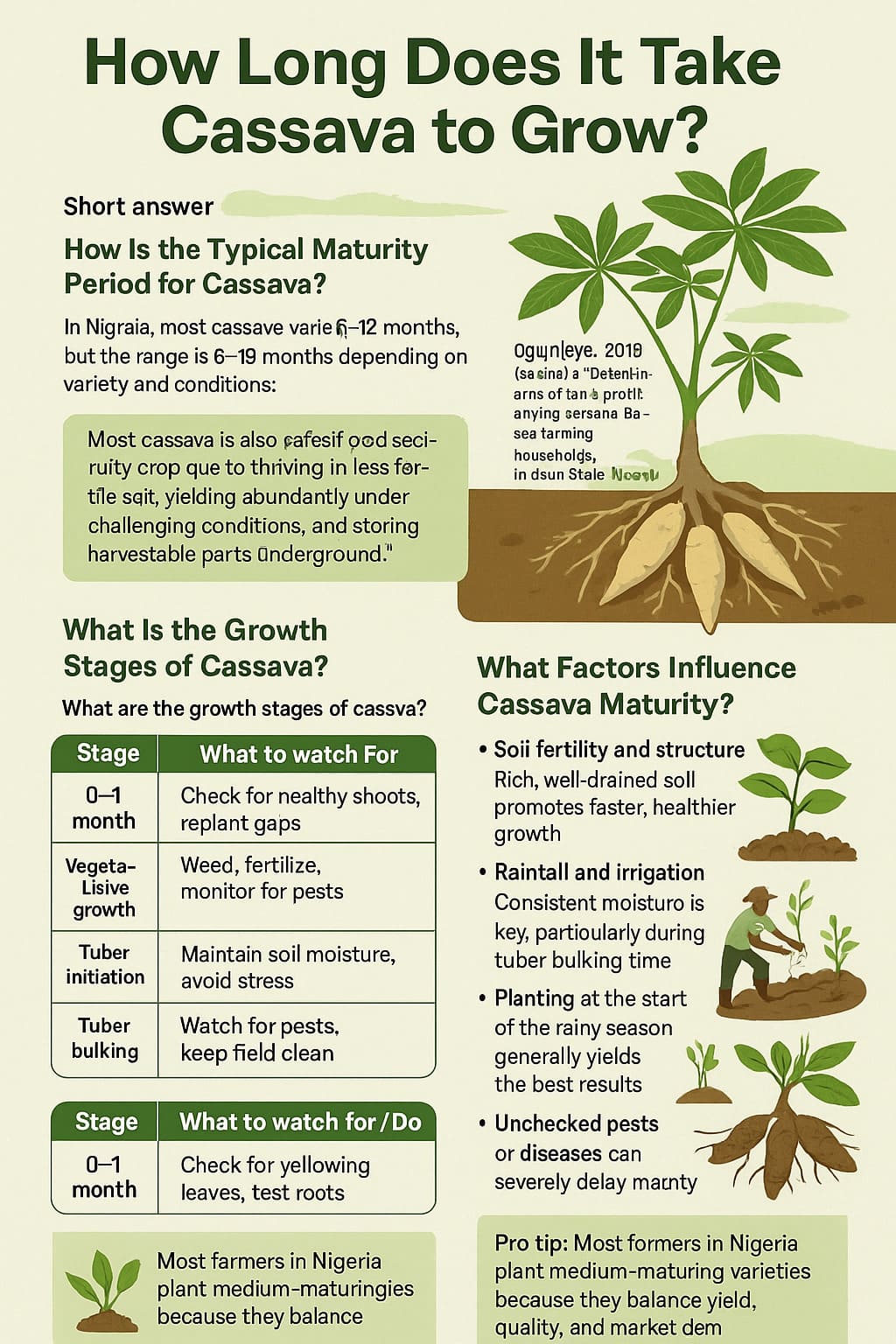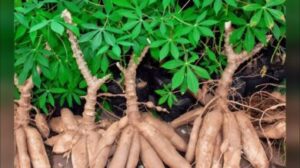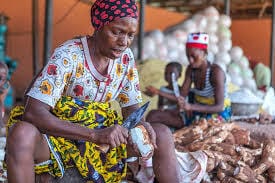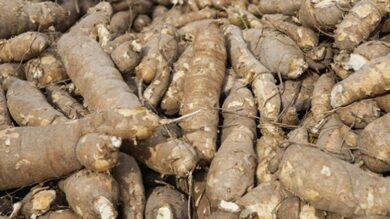Last updated on July 30, 2025
If you’re planning to start cassava farming in Nigeria, one of the first questions you’ll ask is: How long does cassava take to grow? The short answer: Most cassava varieties mature in 9–12 months, but the range can be anywhere from 6 to 18 months depending on the variety, your soil, and how you manage your farm. These timelines are general and can vary based on local conditions and varieties in other countries.
Why does this matter? Because timing your harvest right is the difference between a bumper profit and a disappointing yield. I’ve learned (sometimes the hard way) that knowing your cassava’s growth timeline helps you plan, avoid mistakes, and get the best out of your land. If you harvest too early, you lose yield and starch. If you wait too long, roots can become woody or rot in the ground.
“Cassava stands out as a classic food security crop due to its combined ability to flourish in less fertile soil, yield abundantly under challenging conditions, and store harvestable portions underground.” — Ogunleye, 2019 (as cited in “Determinants of farm profit among cassava-based farming households in Osun State Nigeria: robust estimation approach” by Taylor & Francis Online)
What Is the Typical Maturity Period for Cassava in Nigeria?
In Nigeria, most cassava varieties mature in 9–12 months, but the range is 6–18 months depending on variety and conditions.
Cassava maturity period depends on the variety you plant and your local conditions:
- Early-maturing varieties: 6–8 months (rare, usually for quick cash or special markets)
- Medium-maturing varieties: 9–12 months (most common, e.g., TME 419, TMS 30572)
- Late-maturing varieties: 13–18 months (some local or specialty types)
| Variety Type | Example Varieties | Typical Maturity (Months) | Best Use Cases |
|---|---|---|---|
| Early-maturing | TMS 92/0326, TMS 92/0057 | 6–8 | Quick cash, niche markets, immediate consumption |
| Medium-maturing | TME 419, TMS 30572 | 9–12 | General farming, garri, fufu, balanced yield/quality |
| Late-maturing | Some local types | 13–18 | Specialty foods, high-quality starch/fufu |
Why does this range exist? Improved varieties are bred to mature faster and give you a good harvest in less than a year. Local varieties may take longer but sometimes have special qualities (like taste or suitability for certain foods).
Pro tip: Most farmers in Nigeria plant medium-maturing varieties because they balance yield, quality, and market demand. If you want to know which variety is best for your area, see Best Cassava Variety in Nigeria.

What Are the Growth Stages of Cassava? (Month-by-Month Timeline)
Understanding the cassava growth stages helps you know what to expect and when to act. Here’s a practical month-by-month breakdown:
0–1 Month: Sprouting
- What happens: Cuttings start to sprout. You’ll see new leaves in 1–3 weeks if your cuttings are healthy and the soil is moist.
- What to do: Keep the field weed-free and check for any cuttings that didn’t sprout (replace them early).
1–4 Months: Vegetative Growth
- What happens: Plants grow fast, putting out leaves and stems. This is when cassava builds its “engine” for later root growth.
- What to do: Weed regularly, apply fertilizer or manure if needed, and watch for pests like grasshoppers or termites.
4–6 Months: Tuber Initiation
- What happens: Roots start to swell underground. Above ground, the plant may look less “busy,” but underground, the real work begins.
- What to do: Maintain soil moisture, avoid water stress, and keep weeds under control.
6–10 Months: Tuber Bulking
- What happens: Roots grow rapidly, gaining size and starch. This is the most important period for yield.
- What to do: Continue pest and disease control, and make sure the field doesn’t dry out.
9–18 Months: Maturity
- What happens: Leaves start to yellow and drop, especially the lower ones. Roots reach full size and starch content.
- What to do: Start test harvesting to check root size and quality. Plan your main harvest.
| Month | Stage | What to Watch For / Do |
|---|---|---|
| 0–1 | Sprouting | Check for healthy shoots, replant gaps |
| 1–4 | Vegetative growth | Weed, fertilize, monitor for pests |
| 4–6 | Tuber initiation | Maintain soil moisture, avoid stress |
| 6–10 | Tuber bulking | Watch for pests, keep field clean |
| 9–18 | Maturity | Check for yellowing leaves, test roots |
Farmer’s story: The first time I grew cassava, I got worried at 4 months because the plants looked “stuck.” A local extension officer told me the roots were bulking underground—and he was right! Patience pays off.
How Do Cassava Varieties Affect Growth Duration?
Not all cassava is created equal. Some varieties are bred to mature faster, while others take their time but may yield more or have special qualities.
- Fast-maturing: Some improved varieties (like TMS 92/0326) can be ready in 6–8 months, but yields may be lower and roots may not store well in the ground.
- Medium-maturing: Popular varieties like TME 419 and TMS 30572 mature in 9–12 months and are reliable for most Nigerian climates. These are the “sweet spot” for most farmers.
- Late-maturing: Some local types or specialty varieties can take up to 18 months, but may be preferred for certain foods or markets (like high-quality fufu or starch).
“Our focus is on creating cassava varieties that increase yields for farmers and meet the quality demands of processors and industries. This holistic approach is crucial for sustainable transformation.” — Prof. Chiedozie Egesi, Executive Director, National Root Crops Research Institute (NRCRI), Nigeria (Source: IITA News, “World Cassava Day 2025: Propelling Nigeria and Africa towards agricultural transformation”)
“IITA scientists have played a leading role in developing improved cassava varieties which are disease- and pest-resistant, low in potential to generate cyanide, drought-resistant, early maturing, and high yielding.” — International Institute of Tropical Agriculture (IITA) (Source: IITA website, “Cassava crop improvement” page)
Advice: Choose your variety based on your market, climate, and how quickly you need cash flow. For instance, medium-maturing improved varieties like TME 419 and TMS 30572 are generally best for garri (a granular flour from cassava) or fufu (a dough-like staple food from cassava), as they offer a good balance of yield, quality, and market demand. For a full review, see Best Cassava Variety in Nigeria.
What Factors Influence Cassava Maturity?
Several things can speed up or slow down your cassava’s growth:
Soil Fertility and Structure
- Rich, well-drained soil promotes faster, healthier growth.
- Poor, compacted, or waterlogged soil slows everything down, as roots struggle to expand and access nutrients. Consider soil testing to understand your specific needs, and incorporate organic matter like compost or well-rotted manure to improve soil health.
Rainfall and Irrigation
- Consistent moisture is key, especially during the critical tuber bulking phase.
- Drought or waterlogging can significantly delay maturity or reduce overall yield. For small-scale farmers, this might mean mulching to retain moisture, while commercial farmers might consider supplementary irrigation during dry spells.
Optimal Planting Time
- Planting at the start of the rainy season generally yields the best results.
- Late planting can expose your crop to dry season stress, hindering early development. See Best Month to Plant Cassava in Nigeria.
Pest and Disease Management
- Unchecked pests or diseases can severely delay maturity or even ruin your entire crop.
- Common threats include Cassava Mosaic Disease, Bacterial Blight, and termites, requiring regular scouting and timely intervention. Implement integrated pest management (IPM) strategies, such as planting resistant varieties (as recommended by IITA or NRCRI), regular field walks to spot early signs, and appropriate biological or chemical controls when necessary.
Quality of Cuttings
- Healthy, disease-free stem cuttings sprout and grow faster, giving your crop a strong start.
- Old, dry, or diseased cuttings can significantly delay the development of your whole field.
Mistake to avoid: Planting late in the dry season or using poor-quality cuttings can set your farm back by months. I once lost almost a whole season because I used leftover cuttings from a neighbor—never again!
How Can You Tell When Cassava Is Ready to Harvest?
Don’t just guess—look for these signs:
- Leaves start to yellow and fall off (especially lower leaves)
- Roots are big and firm (do a test harvest by digging up 1–2 plants)
- Starch content is high (roots look white and snap easily)
- Plant age matches variety maturity (e.g., 9–12 months for TME 419)
How to do a test harvest: Use a hoe to gently dig up a plant at the edge of your field. If the roots are big, firm, and not woody, you’re good to go.
Checklist for maturity:
- Yellowing leaves?
- Big, firm roots?
- 9–12 months old?
- Roots snap easily and are not fibrous?
If yes, it’s harvest time!
Personal tip: I always do a test harvest at 9 months, then every 2–3 weeks after, until I’m happy with the root size and quality.
What Happens If You Harvest Cassava Too Early or Too Late?
- Too early (before 9 months):
- Small roots, low starch, poor taste, low market value.
- You’ll regret it—trust me, I’ve tried! The garri yield is poor and the roots are watery.
- Too late (after 15+ months):
- Roots become woody, tough, and may rot or get attacked by pests.
- You risk losing your investment, especially if the rainy season returns and roots start to spoil underground.
Real story: A neighbor once left his cassava for 18 months, hoping for “giant” roots. Instead, he got woody, tasteless cassava that nobody wanted to buy.
Lesson: Always plan to harvest at the right time for your variety and market. If in doubt, ask your local extension officer or an experienced farmer.
How to Speed Up Cassava Growth and Avoid Delays
Want your cassava to mature on time (or even a bit faster)? Here’s what works:
- Prepare your soil well: Loosen, add compost or manure if possible. Good soil structure helps roots expand quickly.
- Use healthy, certified cuttings: They sprout faster and resist disease. Don’t cut corners here.
- Plant at the right time: Early rainy season is best. Avoid late planting.
- Weed early and often: Weeds slow down young cassava. The first 3 months are critical.
- Fertilize if needed: Apply a balanced NPK fertilizer (e.g., 15-15-15) at recommended rates, typically 4-6 weeks after planting, or use well-composted organic manure. For commercial farms, soil tests can guide precise nutrient application.
- Control pests and diseases: Don’t wait until you see damage. Scout your field regularly.
- Space your plants correctly: While 1m x 1m is standard for most smallholder farms, commercial operations might adjust spacing slightly based on mechanization needs or specific variety characteristics to maximize yield per hectare.
Pro tip: I once lost a month of growth because I delayed weeding. Early action saves you time and money! If you’re short on labor, consider mulching to suppress weeds.
Frequently Asked Questions (FAQs) About Cassava Growth
How long does cassava take to mature?
Most cassava in Nigeria matures in 9–12 months, but some varieties can be ready in as little as 6 months or as late as 18 months.
Can I harvest cassava in 6 months?
Only a few special varieties mature this early, and yields are usually lower. For most farmers, 9–12 months is best.
Can I leave cassava in the ground after maturity?
Yes, for a few months, but roots may get woody or attacked by pests if left too long. If you must delay harvest, try to sell or process as soon as possible.
Does cassava grow faster in some regions?
Yes—cassava often matures faster in the South (with more rain and better soils) than in drier Northern areas. In the North, maturity may take longer due to dry spells. But good management can make a big difference anywhere.
What’s the fastest maturing cassava variety in Nigeria?
Some improved types like TMS 92/0326 can be ready in 6–8 months, but most farmers prefer medium-maturing types for better yield and quality.
Key Takeaways
- Most cassava matures in 9–12 months in Nigeria, but variety and management matter.
- Know your variety, watch the growth stages, and harvest at the right time for best results.
- Good soil, healthy cuttings, and timely weeding make a big difference.
- Don’t rush or delay your harvest—timing is everything!
- If you’re new, ask for advice from local extension officers or experienced farmers.
Conclusion
Getting the timing right is one of the most important skills in cassava farming in Nigeria. While most cassava varieties mature in 9–12 months, your actual harvest time depends on your variety, soil, weather, and how well you manage your field. Don’t just guess—watch your plants, do test harvests, and listen to local advice.
From my own experience, patience and good management always pay off. Rushing to harvest too early means you’ll miss out on yield and profit, while waiting too long can turn your hard-earned roots into woody, unsellable lumps. If you’re ever unsure, ask an extension officer or a successful farmer nearby—they’ve likely faced the same questions.
Remember: Healthy cuttings, good soil, timely weeding, and the right harvest window are your best friends. With the right approach, you’ll get the most from your cassava farm—season after season.
Wishing you a successful and bountiful cassava harvest!
See Also: More Cassava Farming Resources
- How to Start Cassava Farming in Nigeria
- Best Cassava Variety in Nigeria
- How Much Do I Need to Start a Cassava Farm?
- Best Month to Plant Cassava in Nigeria
Feel free to leave a comment or question below if you have more insights or need further clarification on cassava farming!


